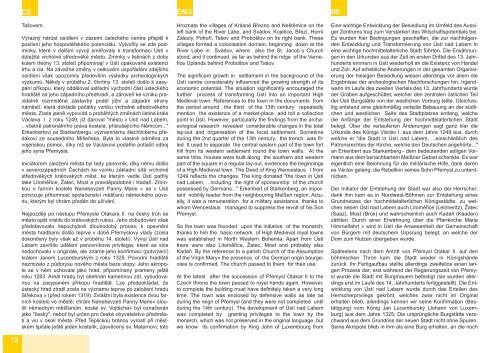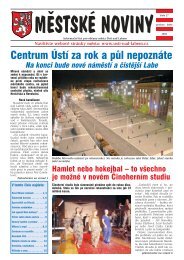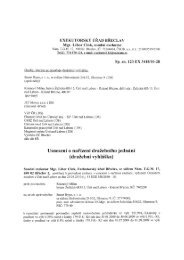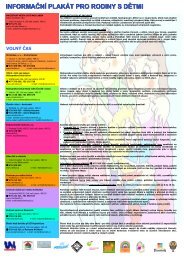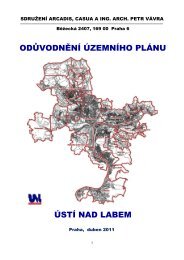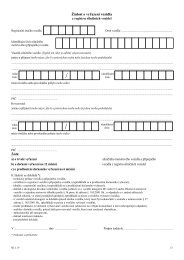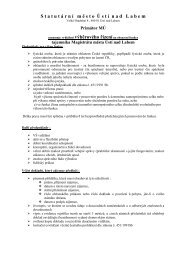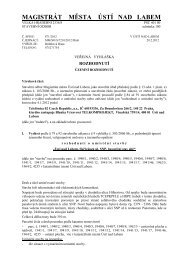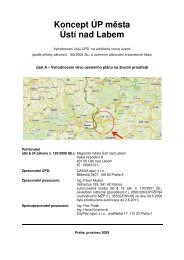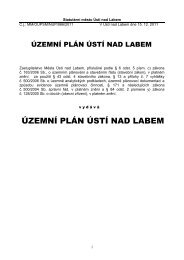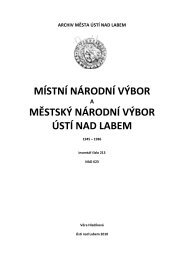Historie a památky města Ústí nad Labem History and monuments of ...
Historie a památky města Ústí nad Labem History and monuments of ...
Historie a památky města Ústí nad Labem History and monuments of ...
Erfolgreiche ePaper selbst erstellen
Machen Sie aus Ihren PDF Publikationen ein blätterbares Flipbook mit unserer einzigartigen Google optimierten e-Paper Software.
12<br />
CZ ENG DE<br />
Tašovem.<br />
Výrazný nárůst osídlení v zázemí ústeckého centra přispěl k<br />
posílení jeho hospodářského potenciálu. Vytvořily se zde podmínky,<br />
které v dalším vývoji směřovaly k transformaci <strong>Ústí</strong> v<br />
důležité vrcholně středověké město. Zmínky v listinách z doby<br />
kolem třetiny 13. století připomínají v <strong>Ústí</strong> opakovaně existenci<br />
trhu a cla. Na závažné změny v celkovém uspořádání zdejšího<br />
osídlení však upozornily především výsledky archeologických<br />
výzkumů. Někdy v průběhu 2. čtvrtiny 13. století došlo k zasypání<br />
příkopu, který odděloval ústřední východní část ústeckého<br />
hradiště od jeho západního předhradí, a zároveň ke vzniku pravidelně<br />
rozmístěné zástavby podél jižní a západní strany<br />
náměstí, která dokládá počátky vzniku vrcholně středověkého<br />
<strong>města</strong>. Zcela jasně vypovídá o proběhlých změnách listina krále<br />
Václava I. z roku 1249, jíž daroval "město v <strong>Ústí</strong> <strong>nad</strong> <strong>Labem</strong>,<br />
...včetně patronátního práva kostela, příslušejícího Němcům..."<br />
Erkenbertovi ze Starkenbergu, významnému šlechtickému předákovi<br />
ze sousedního Míšeňska. Byla to vlastně odměna za<br />
vojenskou pomoc, díky níž se Václavovi podařilo potlačit odboj<br />
jeho syna Přemysla.<br />
Iniciátorem založení <strong>města</strong> byl tedy panovník; díky němu došlo<br />
v severozápadních Čechách ke vzniku základní sítě vrcholně<br />
středověkých královských měst, ke kterým vedle <strong>Ústí</strong> patřily<br />
také Litoměřice, Žatec, Most a pravděpodobně i Kadaň. Zmínkou<br />
o farním kostele Nanebevzetí Panny Marie » se v <strong>Ústí</strong><br />
potvrzuje přítomnost společenství měšťanů německého původu,<br />
kterým byl chrám předán do užívání.<br />
Nejpozději po nástupu Přemysla Otakara II. na český trůn se<br />
město opět vrátilo do královských rukou. Jeho dobudování však<br />
představovalo nepochybně dlouhodobý proces; k opevnění<br />
<strong>města</strong> hradbami došlo teprve v době Přemyslovy vlády (zcela<br />
dokončeny byly však až v průběhu 14. století). Vývoj <strong>Ústí</strong> <strong>nad</strong><br />
<strong>Labem</strong> završilo udělení panovníkova privilegia, které se sice<br />
nedochovalo v originále, ale známe jeho konfirmaci (potvrzení)<br />
králem Janem Lucemburským z roku 1325. Původní hradiště<br />
nezmizelo z půdorysu nového <strong>města</strong> beze stopy. Jeho akropole<br />
se v něm uchovala jako hrad, připomínaný prameny ještě<br />
roku 1283. Areál hradu byl obehnán kamennou zdí, vybudovanou<br />
na zasypaném příkopu hradiště. Lze předpokládat, že<br />
ústecký hrad ztratil zcela na významu teprve po založení hradu<br />
Střekova » (před rokem 1319). Zvláštní byla existence dvou farních<br />
kostelů ve městě; chrám Nanebevzetí Panny Marie» sloužil<br />
německým měšťanům, kostel sv. Vojtěcha» byl označován<br />
jako "český", neboť byl určen pro české obyvatelstvo předměstí<br />
a vsí v okolí <strong>města</strong>. Před Teplickou bránou vyrostl při městském<br />
špitále ještě jeden kostelík, zasvěcený sv. Maternovi; toto<br />
Hroznata the villages <strong>of</strong> Krásné Březno <strong>and</strong> Neštěmice on the<br />
left bank <strong>of</strong> the River Labe, <strong>and</strong> Svádov, Kojetice, Březí, Horní<br />
Zálezly, Pohoří, Tašov <strong>and</strong> Proboštov on its right bank. These<br />
villages formed a colonisation domain, beginning down at the<br />
River Labe in Svádov, where also the St. Jacob´s Church<br />
stood, <strong>and</strong> it continued as far as behind the ridge <strong>of</strong> the Verneřice<br />
Upl<strong>and</strong>s behind Proboštov <strong>and</strong> Tašov.<br />
The significant growth in settlement in the background <strong>of</strong> the<br />
<strong>Ústí</strong> centre considerably influenced the growing strength <strong>of</strong> its<br />
economic potential. The situation significantly encouraged the<br />
further process <strong>of</strong> transforming <strong>Ústí</strong> into an important High<br />
Medieval town. References to the town in the documents from<br />
the period around the third <strong>of</strong> the 13th century repeatedly<br />
mention the existence <strong>of</strong> a market-place <strong>and</strong> toll a collection<br />
point in <strong>Ústí</strong>. However, particularly the findings from the archaeological<br />
research revealed considerable changes in the total<br />
lay-out <strong>and</strong> organisation <strong>of</strong> the local settlement. Sometime<br />
during the 2nd quarter <strong>of</strong> the 13th century, the trench was filled.<br />
It used to separate the central eastern part <strong>of</strong> the town fort<br />
hill from its western settlement round the town walls. At the<br />
same time, houses were built along the southern <strong>and</strong> western<br />
part <strong>of</strong> the square in a regular lay-out, evidences the beginnings<br />
<strong>of</strong> a High Medieval town. The Deed <strong>of</strong> King Wenceslaus I from<br />
1249 reflects the changes. The king donated "the town in <strong>Ústí</strong><br />
<strong>nad</strong> <strong>Labem</strong>, ...including the right <strong>of</strong> sponsorship <strong>of</strong> the church<br />
possessed by Germans..." Erkenbert <strong>of</strong> Starkenberg, an important<br />
nobility leader from the neighbouring Meißen region. Actually,<br />
it was a remuneration for a military assistance, thanks to<br />
whom Wenceslaus managed to suppress the revolt <strong>of</strong> his Son<br />
Přemysl.<br />
So the town was founded upon the initiative <strong>of</strong> the monarch;<br />
thanks to him the basic network <strong>of</strong> High Medieval royal towns<br />
was established in North Western Bohemia. Apart from <strong>Ústí</strong><br />
there were also Litoměřice, Žatec, Most <strong>and</strong> probably also<br />
Kadaň. By the reference to a parish Church <strong>of</strong> the Assumption<br />
<strong>of</strong> the Virgin Mary» the presence <strong>of</strong> the German origin bourgeoisie<br />
is confirmed. The church passed to them for their use.<br />
At the latest after the succession <strong>of</strong> Přemysl Otakar II to the<br />
Czech throne the town passed to royal h<strong>and</strong>s again. However,<br />
to complete the building must have definitely taken a very long<br />
time. The town was enclosed by defensive walls as late as<br />
during the reign <strong>of</strong> Přemysl (<strong>and</strong> they were not completed until<br />
during the 14th century). The development <strong>of</strong> <strong>Ústí</strong> <strong>nad</strong> <strong>Labem</strong><br />
was completed by granting privileges to the town by the<br />
monarch, which was not preserved in the original language, but<br />
we know its confirmation by King John <strong>of</strong> Luxembourg from<br />
Eine wichtige Entwicklung der Besiedlung im Umfeld des Aussiger<br />
Zentrums trug zum Verstärken des Witschaftspotentials bei.<br />
Es wurden hier Bedingungen geschaffen, die zur nachfolgenden<br />
Entwicklung und Transformierung von <strong>Ústí</strong> <strong>nad</strong> <strong>Labem</strong> in<br />
eine wichtige hochmittelalterliche Stadt führten. Die Erwähnungen<br />
in den Urkunden aus der Zeit im ersten Drittel des 13. Jahrhunderts<br />
erinnern in <strong>Ústí</strong> wiederholt an die Existenz von H<strong>and</strong>el<br />
und Zoll. Auf erhebliche Änderungen in der gesamten Organisierung<br />
der hiesigen Besiedlung wiesen allerdings vor allem die<br />
Ergebnisse der archeologischen Nachforschungen hin. Irgendwann<br />
im Laufe des zweiten Viertels des 13. Jahrhunderts wurde<br />
der Graben aufgeschüttet, welcher den zentralen östlichen Teil<br />
der <strong>Ústí</strong> Burgstätte von der westlichen Vorburg teilte. Gleichzeitig<br />
entst<strong>and</strong> eine gleichmäßig verteilte Bebauung an der südlichen<br />
und westlichen Seite des Stadtplatzes entlang, welche<br />
die Anfänge der Entstehung der hochmittelalterlichen Stadt<br />
belegt. Über die verlaufenen Änderungen sagt ganz klar die<br />
Urkunde des Königs Václav I. aus dem Jahre 1249 aus, durch<br />
welche er "die Stadt in <strong>Ústí</strong> <strong>nad</strong> <strong>Labem</strong>, ...einschließlich des<br />
Patronsrechtes der Kirche, welche den Deutschen angehörte..."<br />
an Erkenbert aus Starkenberg - dem bedeutenden adligen Vormann<br />
aus dem benachbartem Meißner Gebiet schenkte. Es war<br />
eigentlich eine Belohnung für die militärische Hilfe, dank deren<br />
es Václav gelang, die Rebellion seines Sohn Přemysl zu unterdrücken.<br />
Der Initiator der Entstehung der Stadt war also der Herrscher;<br />
dank ihm kam es in Nordwest-Böhmen zur Entstehung eines<br />
Grundnetzes der hochmittelalterlichen Königsstädte, zu welchen<br />
neben <strong>Ústí</strong> <strong>nad</strong> <strong>Labem</strong> auch Litoměřice (Leitmeritz), Žatec<br />
(Saaz), Most (Brüx) und wahrscheinlich auch Kadaň (Kaaden)<br />
zählten. Durch einer Erwähnung über die Pfarrkirche Maria<br />
Himmelfahrt » wird in <strong>Ústí</strong> die Anwesenheit der Gemeinschaft<br />
von Bürgern mit deutschem Urpsrung belegt, an welche der<br />
Dom zum Nutzen übergeben wurde.<br />
Spätestens nach dem Antritt von Přemysl Otakar II. auf den<br />
böhmischen Thron kam die Stadt wieder in Königshände<br />
zurück. Ihr Fertigaufbau stellte allerdings zweifellos einen langen<br />
Prozess dar; erst während der Regierungszeit von Přemysl<br />
wurde die Stadt mit Burgmauern befestigt (sie wurden allerdings<br />
erst im Laufe des 14. Jahrhunderts fertiggestellt). Die Entwicklung<br />
von <strong>Ústí</strong> <strong>nad</strong> <strong>Labem</strong> wurde durch das Erteilen des<br />
Herrscherprivilegs gekrönt, welches zwar nicht im Original<br />
erhalten blieb, allerdings kennen wir seine Konfirmation (Bestätigung)<br />
vom König Jan Lucemburský (Johann von Luxemburg)<br />
aus dem Jahre 1325. Die ursprüngliche Burgstätte verschw<strong>and</strong><br />
aus dem Grundriss der neuen Stadt nicht ohne Spuren.<br />
Seine Akropole blieb in ihm als eine Burg erhalten, an die noch


